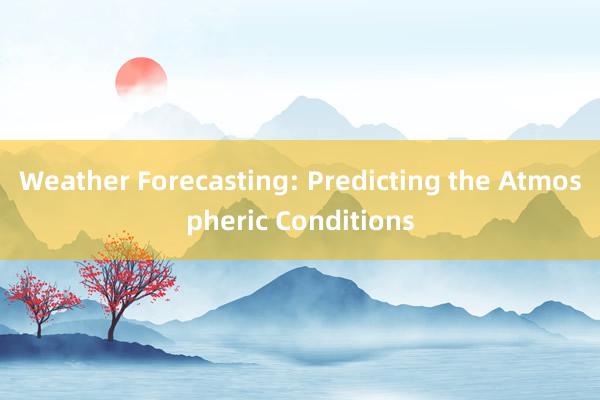时间:2024-10-22 13:12

### Weather Forecasting: Predicting the Atmospheric Conditions
Weather forecasting, the art and science of predicting atmospheric conditions, has evolved significantly over the centuries, from ancient methods relying on natural phenomena to modern technologies utilizing advanced computational models and satellite imagery. This evolution has not only enhanced our ability to predict weather accurately but also improved safety and preparedness for natural disasters, influenced agricultural planning, and optimized various aspects of human life and industry.
化工产品网#### Ancient Techniques
Historically, weather forecasting relied heavily on observations of natural signs. For example, the ancient Greeks noticed that the behavior of animals could indicate coming weather changes. More systematically, early civilizations used the position of stars and the phases of the moon to predict seasonal changes, which were crucial for agriculture. The Chinese, in particular, developed sophisticated calendars and records based on meteorological observations, recognizing patterns that allowed them to forecast seasons and predict rain.
#### The Age of Instruments
As technology advanced, so did the tools used for weather forecasting. In the 19th century, the invention of barometers, 海口市复偶网络科技有限公司 thermometers, 分享生命的感动 and anemometers marked a significant leap. These instruments allowed for more precise measurements of atmospheric pressure,广西洋凌贸易有限公司 temperature, and wind speed, respectively. Meteorologists began collecting data from multiple locations, which they used to make regional forecasts. The establishment of the first weather stations and the development of telegraph systems enabled the rapid dissemination of weather information across long distances.
#### Modern Era: Numerical Models and Computers
The advent of computers in the mid-20th century revolutionized weather forecasting. Instead of relying solely on observations and simple mathematical rules, meteorologists started using complex numerical models that simulate the Earth's atmosphere. These models solve equations that describe how air moves,莱芜利丰纺织有限公司 heats up, cools down, and reacts with other elements like water vapor and greenhouse gases. By inputting current weather conditions into these models, meteorologists can predict how the atmosphere will evolve over time.
#### Satellite Technology
The introduction of satellites in the late 20th century provided a new dimension to weather forecasting. Satellites orbiting the Earth can capture images of clouds, temperature, and moisture content at high resolution, allowing for continuous monitoring of global weather patterns. This real-time data is crucial for short-term forecasts, such as predicting severe weather events like hurricanes or tornadoes, and for long-term climate studies.
#### Challenges and Future Directions
Despite significant advancements, weather forecasting faces challenges, particularly in predicting extreme weather events with high precision. Climate change introduces complexities, requiring more sophisticated models that can account for the changing dynamics of the atmosphere. Additionally, there is a growing need for more accurate and timely forecasts in sectors such as aviation, agriculture, and emergency management.
#### Conclusion
Weather forecasting, from its ancient roots to the sophisticated systems of today, demonstrates the power of human ingenuity in understanding and predicting the natural world. As technology continues to advance, we can expect even more accurate and personalized weather predictions, enhancing safety, efficiency, and sustainability across various industries and everyday life. The future of weather forecasting promises to be both exciting and transformative莱芜利丰纺织有限公司, offering new opportunities to harness the power of the atmosphere for the benefit of humanity.